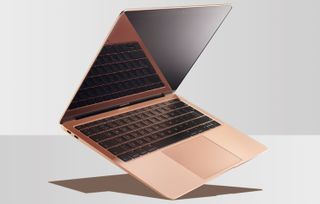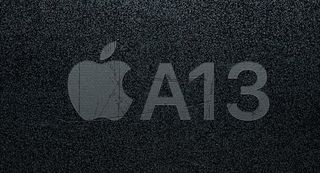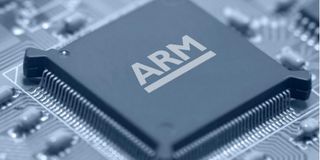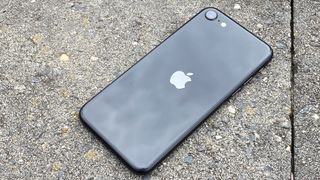A 'MacBook SE' could destroy Chromebooks and Windows laptops in one fell swoop
An ARM-based MacBook SE could destroy Chromebooks and mid-priced Windows laptops in one fell swoop

Apple might be bringing back the 12-inch MacBook, only with a twist: it could use an ARM-based chip. And according to Bloomberg's sources. Apple is planning to sell Mac machines with its own chips by 2021, meaning we could get what would effectively be the MacBook SE next year.
For well over a decade, Apple has been using Intel chips in its laptops, from the original MacBook to the latest MacBook Pro 16-inch. And upcoming Mac machines, such as the MacBook Pro 2020, are set to have the latest slices of silicon from Intel. But if Apple does indeed resurrect the 12-inch MacBook, it could stand out from its stablemates in one major way.
- The best laptops you can buy now
- These are the best Chromebooks you can buy
- Plus: iPhone 12 in trouble? What it needs to beat 'good enough' iPhone SE
Why the first 12-inch MacBook failed
The 12-inch MacBook launched back in 2015, as the slimmest and lightest MacBook around, yet was also a machine that didn’t skimp on build or display quality. At the time it was seen as something that could replace the discontinued original MacBook and replace the old MacBook Air; only it didn’t.
As beautifully designed as it was, the 12-inch MacBook was underpowered thanks to its use of Intel’s Core M processors. It also came with a single USB-C port and used the low-profile Butterfly keyboard mechanism that has been lambasted for being unreliable and not to everyone’s typing tastes.
And the MacBook was expensive for a device with entry-level specs. At launch, it cost $1,299, which was a good few hundred dollars more expensive than the MacBook Air, which despite having a dated design still had decent specs and plenty of ports. If you’d have spent a hundred dollars or so more and you’d have got an entry-level 13-inch MacBook Pro, which offered a lot more power in a still reasonably slim package.
Apple updated the MacBook’s innards in 2017 but it wasn’t really enough, and towards the end of 2018 the new MacBook Air made its debut offering more power, a larger Retina display and more ports for $1,199.
The new Air was basically game over for the 12-inch MacBook as it didn’t really fit anywhere in the MacBook lineup being too underpowered and expensive to make it worth getting over a MacBook Air or 13-inch MacBook Pro. So the 12-inch MacBook was quietly put out to pasture in early 2019.
MacBook with ARM power incoming
One reliable albeit anonymous tech leaker on Twitter said the 12-inch MacBook will be back and it will shun Intel chips in favour of an ARM-based one.
There’s been chatter for some time that Apple might move away from Intel chips and make its own silicon for the MacBook lineup. But making laptop and PC-grade chips is not an easy process, especially if you don’t have access to your own foundry.
However, this isn’t Apple’s first rodeo, as it’s been designing its own A series chips for iPhones, iPads, and the Apple Watch for several years. The engineers at Cupertino first started out making chips that incorporated CPU designs from chip designer ARM - pretty much every mobile chip in the world uses ARM-based designs - with GPUs from PowerVR.

Apple then started to design its own chips from scratch, using its own custom processors. All these chips were still based on the underlying ARM reduced instruction set computing (RISC) architecture, again like virtually every smartphone and tablet chip in the world.
It’s likely that if Apple does make a new MacBook powered by an ARM-based chip it will probably be a custom A-series chip it designs in house; after all, it already has the manufacturing partners and supply chains to make such chips.
And Geoff Blaber, vice president of research at analyst house CCS Insight, reckons "it’s not a question of if, but when Apple deploys ARM in its Mac lineup."
"Apple has made enormous investments in ARM silicon design and it’s logical that it extends that capability beyond iPhone and iPad. Reducing its dependence on Intel, cost and increasing roadmap flexibility and agility are all key motivations," said Blaber.
So Apple has the skills and the tech, but why would it make such a MacBook when it has stuck with Intel for years?
Taking on Chromebooks and cheaper Windows laptops
The simple answer to that can be seen with Chromebooks that use ARM-based chips, and Microsoft’s “Always Connected PC” initiative, which has seen Windows 10 laptops powered by ARM-based Qualcomm Snapdragon SoCs (system-on-a-chip). These machines have all been designed to handle straightforward everyday computing - think word processing, emails, video calls, and Netflix binging - for hours on end; at least a day’s worth of battery life.
Such laptops aren’t designed to be powerhouse machines, so they don’t need Intel or AMD processors, meaning lower-powered mobile chips will do.
As it stands, Chromebooks are popular among students but are generally rather basic, with more premium models being expensive and using Intel CPUs. And Chrome OS simply isn’t as flexible or flush with apps as macOS or Windows 10.
Always Connected PCs, on the other hand, struggle with widespread app compatibility as Windows 10 was originally designed to run on chips that use IBM’s x86 architecture, which happens to be used by all Intel and AMD CPUs. RISC architecture is fundamentally different to x86, so emulation is required to get Windows 10 and its third-party apps running on ARM-based chips.
All this means there’s a gap in the market for Apple to make a low-powered yet well-made and keenly priced laptop to offer more flexibility than Chromebooks and bypass the shortcomings of Windows 10 on ARM; something Blaber says Apple can learn from.
"Microsoft’s experience with Windows is the blueprint for both the potential and the pitfalls of introducing ARM alongside Intel in the Mac lineup," says Blaber, noting that while there are advantages to using ARM chips, and Microsoft and Apple have a strong developer ecosystem, it's still a challenge to move away from Intel and x86.
"The practical reality of emulation as a stepping stone and ensuring the long tail of apps and plug-ins can run is extremely difficult," Blaber continued. "Apple can make final Cut Pro and iWork run seamlessly, guaranteeing plug-ins behave on ARM is another matter”.
This means Apple will need to find a way to get macOS to play nicely on RISC architecture. But unlike Microsoft, Cupertino’s smart folks already have experience in creating an operating system that runs on ARM chips in the form of iOS.

Apple's walled garden advantage
With iPadOS now offering macOS-like features, as well as keyboard and trackpad support, it’s arguably not too much of a challenge for Apple to rework macOS to run on RISC and ARM.
One of the main problems of Windows 10 on ARM is not so much getting the operating system running, but also ensuring that people can access the plethora of third-party apps they are accustomed to thanks to the open nature of Windows. This means getting developers on board, which is a tricky proposition when ARM-based Windows 10 laptops are hardly prolific. Why would the developers go to the effort if they aren’t going to serve a large audience?
Apple’s walled garden approach to software and its operating systems could be the ace up its sleeve here. Apps on macOS need to be vetted by Apple before they make it onto its App Store, so Apple has more control over its app ecosystem and thus more pull than Microsoft to encourage developers to rework their apps to work on RISC as well as x86 operating systems.
The vast wealth of Apple and a narrower scope than Microsoft - Apple isn’t creating an Xbox Series X rival for example - also means it has the money to incentivize developers to create apps that work on an ARM-based MacBook.
Moving from Intel to ARM for its MacBook also gives Apple more control over how the chips in its laptops work. according to Avi Greengart, lead analyst at Techsponential.
"By designing its own chips, Apple can also tailor the tradeoffs it makes between CPU performance, GPU performance, AI performance, battery life, heat dissipation, and cost," says Greengart. "The secondary reasons to move to ARM are differentiation – not having the same chipset as Windows competitors – and performance – the A13 in the iPad Pro already outperforms the Intel processors in the MacBook Pro on some benchmarks."
Given the cult-like following Apple has, if it can make a 12-inch MacBook that sits somewhere between say $600 and $900, and retains a premium design, then it’ll almost certainly sell like crazy. This is another incentive for macOS app developers to get on board as they’d have a strong guarantee that efforts to rework their apps would pay dividends, both figuratively and literally.
According to Greengart, Apple wouldn't even need to position an ARM-based MacBook as a new machine in the same way Microsoft and Qualcomm did with the Always Connected PCs.
"This has not worked well, in part because the products did not live up to the promises," he says about Always Connected PCs. "As long as any MacBooks that run on ARM are simply solid replacements for Intel-based MacBooks, Apple can position them as laptops, not something new that competes with laptops. That will sidestep the whole problem."
Get ready for a MacBook SE
You’d be forgiven for asking why Apple would bother resurrecting the 12-inch MacBook, let alone popping an ARM-based chip in it, as it already has a variety of laptops at different price points. The MacBook Pros suit creative professionals, the MacBook Air is a premium ultraportable, the iPad Pro 2020 with its Magic Keyboard is a solid laptop alternative, and the rest of the iPad range with optional keyboards can be seen as Apple’s pseudo-Chromebook-like devices.
But on the high-end, Apple’s MacBooks are facing stiff competition from premium and powerful Windows 10 laptops like the Dell XPS 13, which undercuts equivalent MacBook Pros. And the MacBook Air is no longer the hugely desirable ultraportable it once was, with the likes of the Surface Laptop 3 offering a premium slim and light laptop for a competitive price.
As such, having a MacBook that undercuts the competition thanks to clever engineering and chip choice, could be a hit for Apple. With the iPhone SE 2020, we now see an Apple that’s no longer completely focused on providing expensive premium gadgets to dedicated fans.

The iPhone SE is likely to get a lot of attention from people who’ve previously avoided iPhones due to their price tag exceeding $500. The new iPhone, which basically takes Apple’s powerful A13 Bionic chip found in the iPhone 11 Pro, and puts it in an iPhone 8 chassis, sets the scene for Apple to do a similar thing with the 12-inch MacBook.
Apple could simply take the 12-inch MacBook bodies and fit them with a chip like the A14 Bionic that's expected to power the iPhone 12, perhaps with a few modifications like a Magic Keyboard. So long as macOS has been tweaked to get along with RISC architecture, then a new MacBook would be ready to go. Apple basically did this with the iPad Air and fifth-generation iPad Mini, which both have rather old external designs but have updated specs.
Ideally, it would be nice to have a redesigned 12-inch MacBook with the latest True Tone Retina display and two Thunderbolt 3 ports instead of USB-C. But if Apple can make a MacBook that’s more affordable than it's ever been, we’re not going to complain if it lacks a few premium features.
It’s not likely to be called the MacBook SE. But if Apple does bring back the 12-inch MacBook with an ARM-based chip, it could have one of the most compelling laptops of 2020 or 2021 and put both Chromebooks and sub-$1000 Windows laptops on notice.
Sign up to get the BEST of Tom's Guide direct to your inbox.
Here at Tom’s Guide our expert editors are committed to bringing you the best news, reviews and guides to help you stay informed and ahead of the curve!
Roland Moore-Colyer a Managing Editor at Tom’s Guide with a focus on news, features and opinion articles. He often writes about gaming, phones, laptops and other bits of hardware; he’s also got an interest in cars. When not at his desk Roland can be found wandering around London, often with a look of curiosity on his face.
-
gentooguy Sigh. Another American tech writer who loves Apple products and believes that everyone else does too. Let me give you a couple of reality checks.Reply
Previous attempts by Apple to compete on price - the iPhone SE and the Mac Mini - didn't move the needle. Only Apple fans bought them. The only exception was the original iPad mini.
The base model MacBook Air? $1000 with an Intel i3 CPU that costs $150. Meaning that even if the CPU were free its price won't drop below $850. You can get a Dell i7 with 12 GB RAM for that. To put it another way ... a Dell with the same internals as a $1000 MacBook Air costs $450. So how much cheaper is a MacBook that uses the same SOC that is in a $1000 iPhone Pro going to be again?
But hey, when your eyes are blinded by fandom that is all you can see. -
ENRIKIUM A 'MacBook SE' will destroy Chromebooks and Windows laptops in one fell swoop : Read moreReally? Why? Because now the consumer will be forced to download apps exclusively from the AppStore? Or because they will be forcing developers to let Apple steal 30% of their earnings? An Apple cult, is like a Trump cult; there is nothing they can do wrong according to their followers.Reply
Also, I love the fact that a 5 year old iPad becomes completely useless because of planned obsolescence. Since the apps now will be controlled by Apple, this obsolescence will be thoroughly enforced. They can choose when to ban apps that still run on old equipment. You know, to make the consumer buy more of their expensive trash more frequently. Steve Jobs talked about the computing dark ages when Windows was king. He was wrong on the timing because we are entering those dark ages and they are led by no one else than Apple.
Remember the Hong Kong protests? Apple banned apps that let the protesters coordinate in their efforts to fight for their Democracy. This ban came after the Chinese govt exerted some pressure on Apple. Money Talks: Is Genius and Magical. No so much "courage" from Apple this time. -
guitarpete987 This is the biggest load of crap I've seen suggested in a while. A cheaper Macbook is not going to end my use of Surface devices or Chromebooks. I hate it when its suggested that we'd all just collapse to our knees at Apple's feet if we could just afford them.Reply
That's more insulting than anything else. -
big_erk As a sysadmin for a large school district with Chromebooks and Macs as well as iPads, I disagree. The Apple products are a pain to manage in quantity. Google has provided tools that make managing 11,000 Chromebooks relatively easy. No, a Chromebook is not going to replace a Mac or a PC for really heavy lifting, but neither is an Arm based MacBook. Besides, 95% of the content we deliver to students is web based or is moving there. Call me when Apple builds something as easy to manage as Chromebooks with a sub $250 price tag.Reply -
MikeandKara Reply
I have a $400 chromebook that meets my needs perfectly. I spend 95% of my time on the web and use a few Android aps as needed. I am like 99% of the users who don't use Photoshop or do video editing. I have a old windows 10 laptop(which I hate) for doing that. I don't understand why people still buy bloated Winows and Mac pc's when 99% would be better served by a Chromebook. It is light, touchscreen, 360 degree hinge, 12 hr battery and a nice keyboard. Plus I just installed the latest Chrome OS update in under a minute.admin said:Apple could be set to resurrect the 12-inch MacBook but this time equip it with an ARM-based chip to take on Windows 10 and Chromebook laptops.
A 'MacBook SE' will destroy Chromebooks and Windows laptops in one fell swoop : Read more
But the one product you should have included in your title was Macbook Air. A sub $500 Macbook Air will destroy the existing Macbook Air. The only way it won't is if Apple puts in old screen technology like iPhone SE. They put a small screen in a relatively large chassis in hopes it won't kill the iPhone 11 series. They could have put a 5.6" screen in a modified(smaller bezels) iPhone 8 chassis. If they did they would have destroyed their high margin phones. That is not the Apple way. -
Petty1969 This could all be true … maybe … except one part; Apple will definitely still use Macbook with a lower case “b” … like they have for years.Reply
I don’t dislike the idea of speculating what Apple will build.
In fact I have a much simplet product that I’ve been speculating Apple will build some day, it’s called:
Mac
… iMac, Macbook, MacBook Air, MacBook Pro, Mac mini, Mac Pro ...
Mac
… haven’t been able to buy a Mac in decades. -
dangen11 Apple anything is hundreds more expensive while pretty much does the same thing as other products. No, Macbook SE is no Chromebook/ Windows killer.Reply
Most Popular


